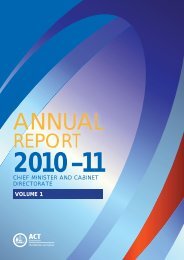Governing the City State - Chief Minister and Treasury Directorate ...
Governing the City State - Chief Minister and Treasury Directorate ...
Governing the City State - Chief Minister and Treasury Directorate ...
You also want an ePaper? Increase the reach of your titles
YUMPU automatically turns print PDFs into web optimized ePapers that Google loves.
The Terms of Reference for <strong>the</strong> Expenditure Review <strong>and</strong> Evaluation Committee should beexp<strong>and</strong>ed to include <strong>the</strong> management <strong>and</strong> coordination of <strong>the</strong> budget process <strong>and</strong> provision ofbriefing to <strong>the</strong> <strong>Chief</strong> <strong>Minister</strong> <strong>and</strong> Treasurer. A sub-committee of <strong>the</strong> Expenditure Review<strong>and</strong> Evaluation Committee – called <strong>the</strong> Budget Coordination Committee – should beestablished with membership from relevant areas of <strong>the</strong> proposed <strong>Chief</strong> <strong>Minister</strong>’sDepartment, <strong>and</strong> a small number of <strong>Directorate</strong> representatives, to oversee planning of <strong>the</strong>Budget process <strong>and</strong> <strong>the</strong> preparation <strong>and</strong> content of procedural advice to <strong>Directorate</strong>s.In broad outline, <strong>the</strong> Budget process should follow a course comprising:• a preliminary meeting of <strong>the</strong> Budget Committee of Cabinet in September or October tosettle broad parameters for <strong>the</strong> Budget (i.e. broad fiscal strategy, requirements of <strong>the</strong>Budget Plan 305 , <strong>and</strong> broad strategic focus for <strong>the</strong> forthcoming Budget in light of agreedpriorities <strong>and</strong> <strong>the</strong> proposed fiscal strategy);• identification, in light of <strong>the</strong> strategic direction articulated in <strong>the</strong> Canberra Plan <strong>and</strong>annual Government priorities, of indicative budget initiatives by <strong>Minister</strong>s;• a second meeting of <strong>the</strong> Budget Committee (November/December) to sift throughproposals <strong>and</strong> determine which are to be fully worked up into budget business cases, <strong>and</strong><strong>the</strong> conditions on which proposals should come forward (e.g. offset, new funding, optionsat different funding levels). This meeting would be supported by joint briefing from <strong>the</strong>Expenditure Review <strong>and</strong> Evaluation Committee on <strong>the</strong> merits of proposals <strong>and</strong> <strong>the</strong>iralignment with Government priorities); <strong>and</strong>• <strong>Minister</strong>s bring forward Portfolio Budget Submissions containing approved businesscases. In light of Cabinet’s determination of clear fiscal targets early in <strong>the</strong> process,including potentially savings initiatives in each portfolio, <strong>Directorate</strong>s would develop for<strong>Minister</strong>s approval, options for Cabinet’s consideration in consultation with <strong>the</strong> proposed<strong>Chief</strong> <strong>Minister</strong>’s Department strictly within those targets (late February).The usual round of Budget Committee meetings would be held through March <strong>and</strong> April toconsider <strong>Minister</strong>s’ Budget Submissions. Meetings would be supported by briefing from <strong>the</strong>proposed <strong>Chief</strong> <strong>Minister</strong>’s Department (including Finance advice). This briefing would beprovided to all <strong>Minister</strong>s two days ahead of meetings. The relevant Director-General wouldattend Budget Committee of Cabinet meetings to support <strong>the</strong>ir <strong>Minister</strong>s.Greater collaboration in <strong>the</strong> preparation of formal briefings to <strong>Minister</strong>s will support morerobust policy debate in settling <strong>the</strong> Budget, <strong>and</strong> better decision making by Cabinet.ConclusionThe success of <strong>the</strong> ACT Government, <strong>and</strong> <strong>the</strong> ACTPS in supporting <strong>the</strong> Government, isfounded on <strong>the</strong> determination <strong>and</strong> articulation of strategic direction, <strong>and</strong> <strong>the</strong> development ofpolicies <strong>and</strong> programs to give effect to that vision. The ACT already has a sophisticatedstrategic planning hierarchy, <strong>and</strong> <strong>the</strong> ACTPS recently concluded important work on305 See www.treasury.act.gov.au/budget/budget_2010/files/paper3/03bplan.pdfStrategy, Resource Allocation <strong>and</strong> <strong>the</strong> Vacant Middle Ground: 237



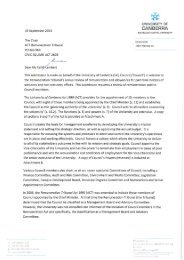
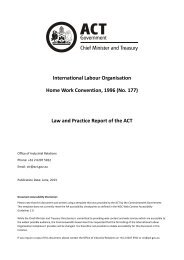
![HSR Training Programs Guidelines [ PDF 191KB]](https://img.yumpu.com/51348280/1/190x245/hsr-training-programs-guidelines-pdf-191kb.jpg?quality=85)


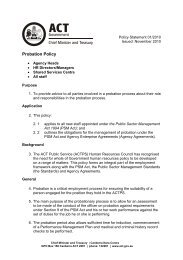
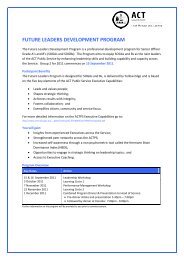

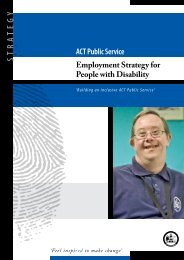
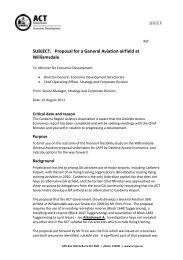
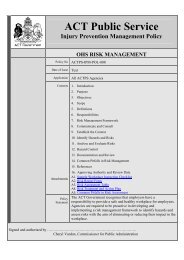
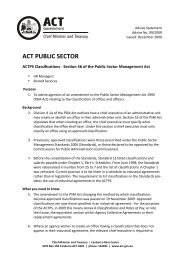
![Teachers Technical and Further Education [ PDF 68KB]](https://img.yumpu.com/34230751/1/184x260/teachers-technical-and-further-education-pdf-68kb.jpg?quality=85)
